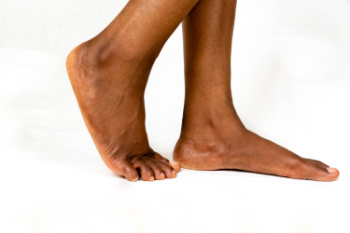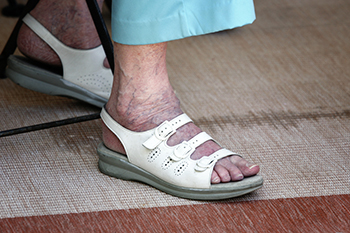Items filtered by date: May 2025
Symptoms of Stress Fractures

A foot stress fracture is a hairline crack in a bone caused by repeated pressure, often seen in the toes, midfoot, or heel. Pain usually begins gradually and worsens during activities like walking or running. It is often felt in one specific area and may seem mild at first, leading many people to ignore it. Unlike other injuries, a stress fracture may not cause swelling or bruising, making it even harder to recognize. As the fracture becomes more severe, the pain may become sharp and limit daily movement. A podiatrist can evaluate the injury by using imaging tests and may recommend a period of offloading. This means reducing weight placed on the injured area to give the bone time to heal. Offloading may involve using crutches, a walking boot, or limiting movement. In some cases, surgery may be needed if the fracture does not heal properly. If you experience symptoms of a stress fracture, it is suggested that you schedule an appointment with a podiatrist for a diagnosis and appropriate treatment.
Stress fractures occur when there is a tiny crack within a bone. To learn more, contact Dr. Paul Drucker from NYC Foot Care, PC. Our doctor can provide the care you need to keep you pain free and on your feet.
How Are They Caused?
Stress fractures are the result of repetitive force being placed on the bone. Since the lower leg and feet often carry most of the body’s weight, stress fractures are likely to occur in these areas. If you rush into a new exercise, you are more likely to develop a stress fracture since you are starting too much, too soon. Pain resulting from stress fractures may go unnoticed at first, however it may start to worsen over time.
Risk Factors
- Gender – They are more commonly found in women compared to men.
- Foot Problems – People with unusual arches in their feet are more likely to develop stress fractures.
- Certain Sports – Dancers, gymnasts, tennis players, runners, and basketball players are more likely to develop stress fractures.
- Lack of Nutrients – A lack of vitamin D and calcium may weaken the bones and make you more prone to stress fractures
- Weak Bones – Osteoporosis can weaken the bones therefore resulting in stress fractures
Stress fractures do not always heal properly, so it is important that you seek help from a podiatrist if you suspect you may have one. Ignoring your stress fracture may cause it to worsen, and you may develop chronic pain as well as additional fractures.
If you have any questions please contact our offices located in 70th Street Manhattan, 60th Street Manhattan, Jamaica, Queens, Plainview, NY and Fair Lawn, NJ . We offer the newest diagnostic and treatment technologies for all your foot and ankle needs.
The Most Common Reason for Heel Pain

Heel pain is a common issue, and, one of the most frequent causes is plantar fasciitis. This condition occurs when the thick band of tissue, known as the plantar fascia that supports the arch of your foot becomes inflamed. It is often caused by overuse, poor foot mechanics, standing for long periods, or wearing unsupportive footwear. Plantar fasciitis typically causes a sharp, stabbing pain in the bottom of the heel, especially with the first steps in the morning or after long periods of rest. The pain may ease with movement but can return after extended activity. A podiatrist can diagnose plantar fasciitis through a physical exam and may use imaging, if needed. Treatment options include stretching exercises, custom orthotics, or anti-inflammatory medications. In more persistent cases, they may recommend cortisone injections or, as a last resort, surgery to release the tight fascia and relieve pressure. If you are experiencing ongoing heel pain, it is suggested that you schedule an appointment with a podiatrist for appropriate treatment.
Many people suffer from bouts of heel pain. For more information, contact Dr. Paul Drucker of NYC Foot Care, PC. Our doctor can provide the care you need to keep you pain-free and on your feet.
Causes of Heel Pain
Heel pain is often associated with plantar fasciitis. The plantar fascia is a band of tissues that extends along the bottom of the foot. A rip or tear in this ligament can cause inflammation of the tissue.
Achilles tendonitis is another cause of heel pain. Inflammation of the Achilles tendon will cause pain from fractures and muscle tearing. Lack of flexibility is also another symptom.
Heel spurs are another cause of pain. When the tissues of the plantar fascia undergo a great deal of stress, it can lead to ligament separation from the heel bone, causing heel spurs.
Why Might Heel Pain Occur?
- Wearing ill-fitting shoes
- Wearing non-supportive shoes
- Weight change
- Excessive running
Treatments
Heel pain should be treated as soon as possible for immediate results. Keeping your feet in a stress-free environment will help. If you suffer from Achilles tendonitis or plantar fasciitis, applying ice will reduce the swelling. Stretching before an exercise like running will help the muscles. Using all these tips will help make heel pain a condition of the past.
If you have any questions, please feel free to contact our offices located in 70th Street Manhattan, 60th Street Manhattan, Jamaica, Queens, Plainview, NY and Fair Lawn, NJ . We offer the newest diagnostic and treatment technologies for all your foot care needs.
Causes and Treatment of Flat Feet

Flat feet occur when the arches of the feet are low or absent, causing the soles to make full contact with the ground while standing. Flat feet may be present from childhood or develop later from weakened tendons, ligament injuries, fractures, or arthritis. Some people with flat feet have no symptoms, but others experience aching in the arches, heels, ankles, or discomfort that extends to the knees and lower back. A podiatrist can diagnose flat feet by examining foot posture and gait, and may use imaging tests to evaluate the bones and soft tissues. When flat feet cause pain, medical treatment options include wearing custom orthotics or specially designed supportive footwear to reduce strain. In more severe cases, surgery may be recommended to strengthen or realign the affected structures in the feet. Early medical care can help manage symptoms and prevent further complications. If flat feet are disrupting your daily activities, it is suggested that you schedule an appointment with a podiatrist for appropriate treatment options.
Flatfoot is a condition many people suffer from. If you have flat feet, contact Dr. Paul Drucker from NYC Foot Care, PC. Our doctor will treat your foot and ankle needs.
What Are Flat Feet?
Flatfoot is a condition in which the arch of the foot is depressed and the sole of the foot is almost completely in contact with the ground. About 20-30% of the population generally has flat feet because their arches never formed during growth.
Conditions & Problems:
Having flat feet makes it difficult to run or walk because of the stress placed on the ankles.
Alignment – The general alignment of your legs can be disrupted, because the ankles move inward which can cause major discomfort.
Knees – If you have complications with your knees, flat feet can be a contributor to arthritis in that area.
Symptoms
- Pain around the heel or arch area
- Trouble standing on the tip toe
- Swelling around the inside of the ankle
- Flat look to one or both feet
- Having your shoes feel uneven when worn
Treatment
If you are experiencing pain and stress on the foot you may weaken the posterior tibial tendon, which runs around the inside of the ankle.
If you have any questions, please feel free to contact our offices located in 70th Street Manhattan, 60th Street Manhattan, Jamaica, Queens, Plainview, NY and Fair Lawn, NJ . We offer the newest diagnostic and treatment technologies for all your foot care needs.
Common Causes of Foot Pain Among Elderly People

Foot pain is a frequent complaint among elderly individuals and can significantly affect mobility and independence. One common cause is hallux valgus, a deformity of the big toe joint that often leads to bunions, swelling, and discomfort when walking. Abnormal structure of the medial arch can also contribute to pain, especially if the arch is excessively high or collapsed, placing extra strain on other parts of the foot. Neurological disorders, such as peripheral neuropathy or spinal issues, can lead to altered sensation, burning pain, or muscle weakness in the feet. These conditions often interfere with balance and walking. If you are a senior or caring for an older person and have foot pain, it is suggested that you visit a podiatrist who can treat various foot conditions.
Proper foot care is something many older adults forget to consider. If you have any concerns about your feet and ankles, contact Dr. Paul Drucker from NYC Foot Care, PC. Our doctor can provide the care you need to keep you pain-free and on your feet.
The Elderly and Their Feet
As we age we start to notice many changes in our body, but the elder population may not notice them right away. Medical conditions may prevent the elderly to take notice of their foot health right away. Poor vision is a lead contributor to not taking action for the elderly.
Common Conditions
- Neuropathy – can reduce feeling in the feet and can hide many life-threatening medical conditions.
- Reduced flexibility – prevents the ability of proper toenail trimming, and foot cleaning. If left untreated, it may lead to further medical issues.
- Foot sores – amongst the older population can be serious before they are discovered. Some of the problematic conditions they may face are:
- Gouging toenails affecting nearby toe
- Shoes that don’t fit properly
- Pressure sores
- Loss of circulation in legs & feet
- Edema & swelling of feet and ankles
Susceptible Infections
Diabetes and poor circulation can cause general loss of sensitivity over the years, turning a simple cut into a serious issue.
If you have any questions, please feel free to contact our offices located in 70th Street Manhattan, 60th Street Manhattan, Jamaica, Queens, Plainview, NY and Fair Lawn, NJ . We offer the newest diagnostic and treatment technologies for all your foot care needs.

